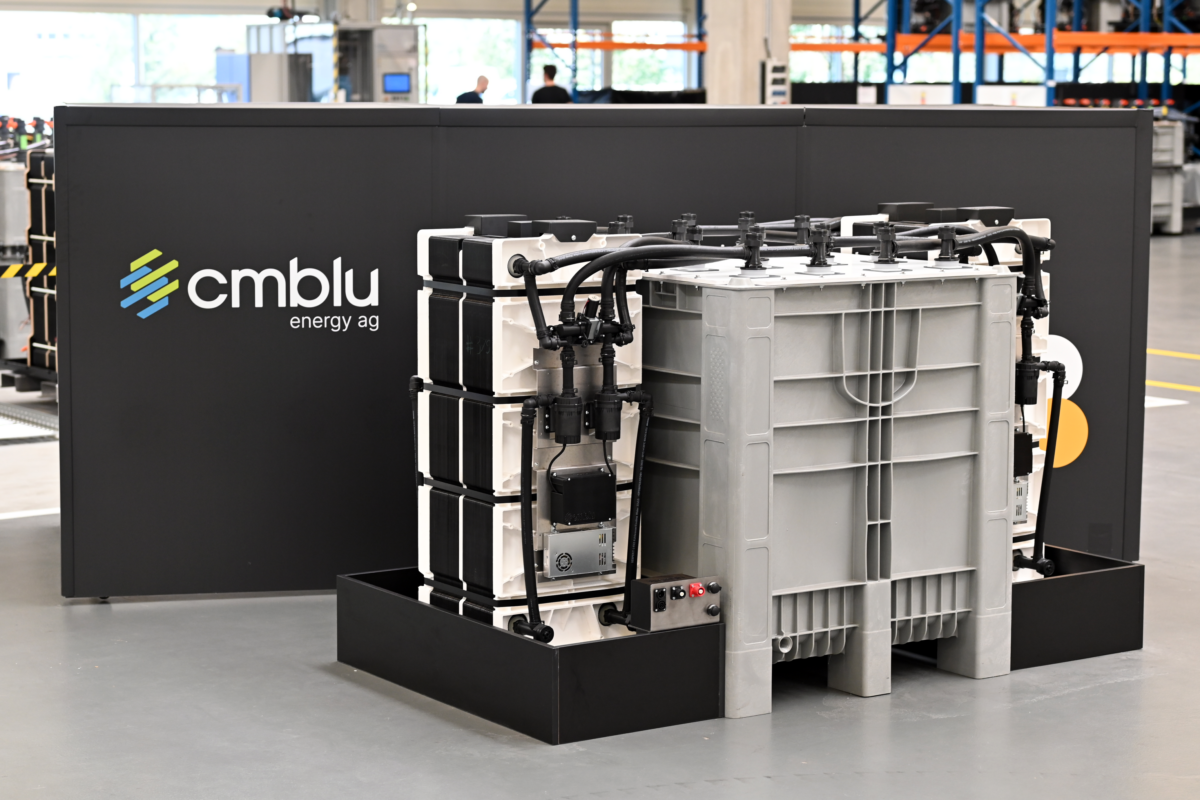CMBlu Energy AG said it has received an order from Mercedes Benz to provide its SolidFlow battery for the carmaker’s plant in Rastatt, Germany. The 11 MWh installation, planned for the second quarter of 2025, will be paired with the facility’s existing solar array.
The CMBlu SolidFlow battery storage system is a development of the flow battery concept, which offers an alternative to lithium-ion batteries and can be scaled for industrial and utility grid energy storage. Flow batteries have tanks of electrolytes, one positively and the other negatively charged, that are pumped into contact with a membrane that collects discharged electricity or charges the system, as required.
Giovanni Damato, president of CMBlu’s U.S. operations, told pv magazine USA that the company’s SolidFlow design incorporates materials that lower the cost and improve the performance of the system. Typically, flow batteries use vanadium in their electrolyte storage that is expensive and sourced from mines in China, Russia and South Africa. The SolidFlow batteries use carbon as a storage medium.
“That’s where we differentiate ourselves from most flow batteries, where in the tanks are typically just liquid electrolyte and can be quite large for long-duration storage,” Damato said. “Whereas we have stationary solids in the tank as well, which improves our energy density. We can have smaller tanks that have a smaller installed footprint.”
One of the attractions of flow batteries is that they do not use lithium, which according to the International Energy Agency is in very high demand for EV batteries, making lithium-ion batteries expensive for industrial and grid energy storage without significant future increases in mining operations around the world. Damato said Mercedes was looking for alternatives to lithium batteries and to extend the hours of storage coverage.
“The key points are that they wanted to move to a sort of a 24/7 renewable model, like the Googles and the Amazons of the world, where they’re using the renewable energy at the time that they need it,” Damato said.
Ideally, Mercedes would rely on its PV installation for onsite electricity needs, charging the flow batteries with surplus for use at night. Damato said the SolidFlow system can meet the company’s requirements for six hours of stored energy and scale up in the future.
“With our modular form factor, we can easily go a from five- or six-hour base up to a 10- or 12-hour base,” he said.
CMBlu characterizes its flow battery system as “organic,” which is another way of saying it uses carbon. The carbon in the system is readily sourced and easy to recycle. Furthermore, the company is eying long-duration and high-density energy storage applications up to the GWh and says its choice of materials and design form will support this strategy.
Damato said the company came through a 10-year research and development effort and is working on pilot projects in Europe and the U.S. The U.S. project is in conjunction with U.S. Department of Energy’s Argonne National Laboratory (Argonne), along with Idaho National Laboratory (INL) in which the researchers intend to validate CMBlu’s long-duration energy storage system. The goal is to improve microgrids in cold climates and make fast charging of electric vehicles more affordable in underserved communities.
The company also has active projects with WEC Energy Group in Wisconsin and at the Salt River Project in Arizona.
CMBlu was among the winners of the 2018 pv magazine Annual Award for its organic flow battery tech.
Written by Michael Puttré, a freelance technology writer.
This content is protected by copyright and may not be reused. If you want to cooperate with us and would like to reuse some of our content, please contact: editors@pv-magazine.com.









By submitting this form you agree to pv magazine using your data for the purposes of publishing your comment.
Your personal data will only be disclosed or otherwise transmitted to third parties for the purposes of spam filtering or if this is necessary for technical maintenance of the website. Any other transfer to third parties will not take place unless this is justified on the basis of applicable data protection regulations or if pv magazine is legally obliged to do so.
You may revoke this consent at any time with effect for the future, in which case your personal data will be deleted immediately. Otherwise, your data will be deleted if pv magazine has processed your request or the purpose of data storage is fulfilled.
Further information on data privacy can be found in our Data Protection Policy.